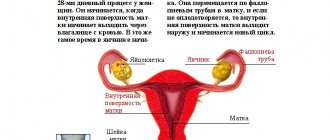The development of teenage girls occurs purely individually. However, the average time period for the onset of the menstrual cycle is 9–14 years. In the first two years, the menstrual cycle may be unstable, which is quite natural, since the body develops, and for this it needs time.
The fact is that menstruation is a serious process associated with the work of sex hormones. At the beginning of puberty, the production of hormones may fail, which naturally affects menstruation.
When menstruation has fully recovered, the average cycle length can be 2-4 days. If menstruation comes with a long delay, and this phenomenon occurs constantly, then it is obvious that some kind of malfunction occurs in the body.
Formation of the menstrual cycle
The approach of menstruation can be noticed by the characteristic signs caused by puberty. After about 10 years and even earlier, girls’ mammary glands begin to become engorged, and abundant hair appears on the pubis and in the armpit. It is secondary sexual characteristics that are an indicator of a girl’s puberty.
Menarche (the first menstruation in a girl's life) is rarely the same as for an adult woman. Usually the first discharge is spotting, scanty, and its duration does not exceed 2-4 days. Only after a few years should cyclicality be established - equal periods of time between menstruation and the same average duration of critical days.
Irregular menstrual cycles in adolescents are especially common in the first year. At 12-14 years after the start of discharge, the duration of the cycle does not exceed 20-25 days, but in some cases, on the contrary, it can last up to 45 days. This is caused by low levels of the hormone estrogen in the body.
The cycle becomes almost regular at 14-15 years of age. By this time, the hormonal background has stabilized, the concentration of female sex hormones becomes almost the same as in adult women.
The timing of the onset of menarche for most girls is individual and depends on factors such as:
- genetic predisposition;
- rate of sexual development;
- living and food conditions;
- diseases suffered in childhood.
In adolescents, menstruation should occur without severe pain, the appearance of clots, or excessive bleeding. Deviations from this norm require treatment, and when the cycle is established independently, specialist supervision.
Age of onset of menstruation
Girls are approximately 2–3 years ahead of boys in development. Puberty begins earlier: the precursors of menstruation appear from 8 to 10 years, and the process itself lasts from 2 to 5 years. This period is characterized by enlargement of the breasts and adipose tissue, hair growth in the pubic area and in the armpits. The production of hormones responsible for reproductive function - estradiol, progesterone. Menarche should also occur at the designated time.
The approximate age for girls to begin their menstrual cycle is from 12 to 14 years. The girl’s body is gradually preparing to reproduce the reproductive function; all phases of the cycle begin to develop in a timely manner.
Among the standardized criteria for determining the age norm, the external characteristics of girls are distinguished:
- Low stature and slow development provoke a delay in menstruation.
- Tall growth and excessive body weight accelerate the onset of the first cycle.
Find out in one of our articles what the menstrual cycle is.
Causes of irregular periods
Menstrual irregularities in girls can occur for various reasons:
- heredity plays an important role in the functioning of the reproductive system of adolescents. In most cases, hormone levels and ovarian function in particular are determined by genetic predisposition;
- external factors. Unfavorable environmental conditions, stress, physical and mental stress negatively affect the maturation, including puberty, of a teenage girl;
- Irregular menstruation can be caused by increased physical activity, sports, lack of proper rest, abuse of gadgets;
- passion for diets. A low body mass index and excessive thinness lead to delayed puberty, reduce the level of sex hormones, and delay the onset of menstruation as much as possible. Excess body weight and obesity also negatively affect a girl’s sexual health;
- some gynecological diseases, a decrease or excess of hormones in the blood due to disruption of the thyroid gland, diseases of the central nervous system also cause disruption of the menstrual cycle;
- Anomalies in the structure of the uterus and other genital organs often lead to untimely onset of menarche or cycle disruptions.
Since the girl’s reproductive system is in the process of development, any external or internal negative factor has an impact on it. Past viral and other diseases, unhealthy diet, smoking and drinking alcohol, lack of proper sleep and rest - all this negatively affects the general health and leads to menstrual cycle disorders.
Why teenagers don't have periods: reasons other than pregnancy
When menstruation was present, but for some reason does not return, they speak of secondary amenorrhea. The concept of a “regular cycle” is generally not characteristic of representatives of the puberty period.
The first two years are a formative stage, so critical days are very unpredictable:
- The younger the girl, the more the delay tends toward the norm.
- The older you are, the greater the risk for developing pathologies.
That is why in a 13- or 14-year-old girl, a delay in menstruation does not indicate pathology. However, regular irregularities in the menstrual cycle in 16-year-old girls are a sign of complications in establishing a cycle.
To eliminate the problem, it is necessary to determine the cause of the cycle failure in a teenager.
| Cause | Impact factors | Negative consequences |
| Metabolic failure | Poor nutrition (heavy foods, fats, sugar, etc.) | Hormonal imbalance |
| Hemoglobin deficiency | Blood loss or lack of vitamins in the body | Pale skin and mucous membranes, increased fatigue, pressure surges |
| Too active lifestyle | Vitamin deficiency as a result of burning too many calories | Suspension of development of the reproductive system |
| Increased mental load | Lack of “work and rest” mode | Delay due to mental overstrain |
| Emotional instability | Stress, unstable relationships with peers or parents | Blocking of oxytocin and endorphin (“happy hormones”) due to the production of cortisol (“stress hormone”) |
| Taking antibiotics | Effect on the pituitary gland | A surge of male hormones. There may be a delay in menstruation after taking antibiotics |
| Endocrine diseases | Diabetes mellitus, thyroid pathologies | Hormonal imbalance |
| Hypothermia of the genitals | Sitting on cold surfaces | Development of infectious diseases |
| Acclimatization | Change in climate zone of residence | Absent, since the cycle is quickly restored |
The reasons described above rarely provoke painful symptoms. But, if a girl, in the absence of menstruation, feels pain in the abdomen or lower back, lethargy and apathy are observed, she should consult a gynecologist for timely detection of complications.
Read about why periods sometimes start 2 weeks after your period ends in the article at the link.
When to worry
In addition to physiological reasons, disruption of the menstrual cycle in girls can be caused by the following factors:
- increased concentration of prolactin;
- syndrome;
- decreased blood clotting;
- pathological structure of the uterus, ovaries;
- thyroid diseases;
- polyps, endometritis, cysts;
- infectious and inflammatory processes in the genital organs.
Menstrual irregularities in adolescents require consultation with a doctor in the following cases:
- no menstruation for more than 3-4 months in a row;
- the cycle has been 45 days or more in recent months;
- critical days twice a month with an interval between them of 14 to 20 days;
- the duration of bleeding is 7 days or more;
- too, when the tampon and pad must be changed more often than once every 2 hours;
- absence of menstruation at 16 years old.
Pathology is also indicated by symptoms such as excessive hair growth on the body and face, sudden weight loss or gain, changes in skin condition (acne, increased oiliness), and the appearance of oily seborrhea on the scalp. All these signs indicate a hormonal imbalance and require correction.
In addition, if a girl is sexually active, pregnancy, including ectopic pregnancy, and the development of various STDs cannot be ruled out.
When is an irregular cycle normal?
The duration of the normal menstrual cycle is different for each woman, but it should be a minimum of 21 days and a maximum of 35. A slight deviation from this indicator is allowed, but only if such a duration is a genetic feature of the body. Irregular periods can be of several types:
- spontaneous;
- one-time (most often it is provoked by external factors: change in climate zone, stress, sudden weight loss);
- long lasting;
- on an ongoing basis.
In some cases, an unstable cycle can be considered a variant of the norm; it is provoked by certain processes that occur in the body at different periods of a woman’s life.
Age-related changes
The first periods in a teenage girl begin at the age of 11-14; after menarche, for another one or two years, it is quite normal for menstruation to occur chaotically. At this time, the development of the reproductive organs occurs and the level of hormones responsible for all processes in the reproductive system normalizes. In teenagers, periods can appear several times a month and disappear for up to six months. There is no need to sound the alarm if, despite the absence of regulation, there are no pathological symptoms, but if girls experience pain in the lower abdomen or unusual vaginal discharge, they should immediately seek medical help.
Do not forget that at puberty there may be pathological causes of delays and irregular menstrual cycles. These include:
- problems with excess weight;
- autonomic dysfunction of the cardiovascular system;
- frequent colds;
- head injury;
- infectious pathologies of the genital area;
- ovarian sclerocystosis;
- abnormalities in the development of reproductive organs;
- tendency to diet, which is provoked by vitamin deficiency.
A normal occurrence may be the chaotic arrival of menstrual periods in women after 40-45 years. At this time, many begin premenopause, which is characterized not only by interruptions in the cycle, but also by hot flashes, psycho-emotional disorders, weight gain, and sleep problems. During the premenopausal period, the reproductive function of the ovaries begins to fade; follicles no longer mature in every cycle, and without ovulation, changes also affect the inner mucous layer of the uterus. As the body prepares for menopause, it is natural that a woman’s menstrual cycle will be disrupted. Despite the fact that during premenopause the regulation becomes disrupted, a woman can still get pregnant, if this is not part of her plans, she must take precautions.
Irregular periods after childbirth
After pregnancy and birth of a baby, the menstrual cycle becomes disrupted. If the mother immediately switches the child to artificial formula, then the first changes may appear 2-4 months after birth. Further, up to six months, periods may be characterized by irregularity. Such disorders do not require drug treatment. A mother who is not breastfeeding should consult a doctor in the following cases:
- 3 months have passed since the birth of the baby, and there are no regulations;
- if six months have passed since the arrival of the first regula, and the cycle has not returned to normal;
- if the delay between menstruation is more than three months.
New mothers should remember that with irregular periods, a woman can become pregnant, so you need to use contraception if a second pregnancy is not yet planned.
If after birth the child is breastfed, then the first period may not come earlier than six months later. At the age of 6 months, the child begins to be given complementary foods, and the level of prolactin gradually decreases, so it is from this moment that breastfeeding mothers may begin to experience irregularities. But there are situations when during lactation the regulations are completely absent until the baby completely refuses breast milk.
During breastfeeding, menstruation is very often absent, since increased production of prolactin suppresses the ovulatory function of the ovaries. Usually the cycle returns to normal when the baby stops receiving breast milk on demand or completely refuses it.
After the birth of a child, there are several reasons to seek medical help if there is no regulation:
- no regulation 3 months after stopping breastfeeding;
- if six months after the end of the lactation period the cycle has not become regular;
- if the regulations are delayed for 3 months or more.
It should be remembered that lactation is not a method of contraception and you can get pregnant even if there is no regulation during breastfeeding.
Taking medications
In some cases, medication may be the cause of irregular periods. These may be hormonal medications, tranquilizers and anticoagulants. Anti-depression medications and anti-seizure medications can cause the same reaction.
Very often, the menstrual cycle is disrupted after a sudden refusal to take contraceptives. In such a situation, the cycle is restored in 2-3 months. A visit to the doctor is necessary if the regularity of menstrual periods has not improved 4 months after stopping oral contraception.
Another type of drugs that disrupt the regularity of the cycle are emergency contraception, which can prevent unwanted pregnancy after unprotected sexual intercourse. These are medications such as Postinor and Escapelle. They are based on a large dose of hormones, which affects the functioning of the reproductive system and reduces the likelihood of conception. After taking the drugs, there may be a delay or failure of the cycle for several months. It usually recovers in the next 2-3 months without additional treatment.
Treatment approaches
Before prescribing therapy, diagnostics are carried out to identify the cause of the girl’s irregular menstrual cycle. Diagnostic measures include:
- determination of body mass index;
- examination by a gynecologist;
- Ultrasound of the abdominal organs;
- general urine and blood tests (if necessary, biochemistry can be prescribed), determination of hormonal status.
The choice of drug therapy depends on what caused the failure:
- In case of thyroid dysfunction, hormone therapy may be prescribed. In addition to regular medications, monthly monitoring of hormone concentrations in the blood is carried out;
- prescription of multivitamins, selection of proper nutrition. Vitamins B and E are of particular importance for a growing organism;
- homeopathic medicines for correction of the menstrual cycle.
You should immediately consult a doctor if, in addition to menstrual cycle disorders, there is sudden weight loss, a significant increase in blood discharge during menstruation, intense pain, and the appearance of bleeding between critical days.
The onset of the menstrual cycle in girls is between the ages of 11 and 14 years. Only 1/3 of adolescents have no problems with the frequency of menstruation; in other cases, it takes 6-18 months to normalize the cycle. Normally, a girl should lose about 120 ml of blood and not experience abdominal pain. The duration of the menstrual cycle, its symptoms and frequency do not always correspond to the norm. The causes of NMC and its treatment should be considered.
When to see a doctor
While most menstrual problems are not serious, some symptoms may indicate a more serious condition.
You should see a doctor if a girl has:
- Menstruation did not begin by the age of 15, and the cycle did not become regular after 3 years of menstruation.
- Menstruation has stopped or become irregular. Also tell your doctor if your menstrual cycle is less than 24 days or more than 38 days.
- Heavy and prolonged menstruation. In some cases, significant blood loss can cause iron deficiency anemia. Additionally, heavy bleeding may be a sign of thickening of the uterine wall, thyroid problems, or infections.
- Painful menstruation. It is normal to have cramps for a couple of days, but if the girl cannot carry out her usual activities and the cramps do not stop within 3 days, tell the doctor.
Cycle disorders in adolescents: causes
The establishment of a cycle depends on the girl’s lifestyle. Negative external factors affect the balance of hormones in the body.
There are several reasons leading to amenorrhea:
- Unbalanced diet. Diets, eating difficult-to-digest foods, and dry food lead to metabolic disorders. This provokes menstrual irregularities in adolescents. Girls experience intensive growth and active formation of internal organs. To ensure the normal course of physiological processes, it is necessary to enrich the diet with vitamins and minerals.
- Excessive loads. Intense training or an overly active lifestyle negatively affects a girl’s sexual health. The reason for amenorrhea in this case is increased calorie burning and the body’s lack of nutrients. To prevent the problem, the girl should avoid intense exercise during menstruation and a week before its onset.
- Emotional instability. Stressful situations, disagreements with peers, mental stress affect the frequency of the cycle. With psychological disorders, amenorrhea or delayed menstruation develops. Parents should show the child to a gynecologist and psychologist, since therapy in this case requires an integrated approach.
- Hormonal imbalances. Disruption of the menstrual cycle in adolescents is associated with an excess of progesterone and estrogen. In this case, NMC is accompanied by: pain in the groin and lower back, fainting, nausea.
- Taking certain groups of medications. Antibiotic therapy can cause pituitary dysfunction.
- Untreated viral diseases – cytomegalovirus, herpes.
Among the external causes of anomalies, the following are noted:
- sudden climate change;
- unfavorable family situation;
- polluted atmosphere.
Treatment of the pathology is carried out under the supervision of a gynecologist after identifying the cause. Independent selection of drugs is unacceptable.
Violations
If you notice an irregular menstrual cycle, you should not clarify the situation through your girlfriends, as you may lose sight of the development of a serious illness. If both girls have irregular periods at the age of 14, this does not mean that this condition is normal.
In fact, an unstable menstrual cycle may be a consequence of malfunctioning of the endocrine system, inflammatory processes occurring in the genital area, or the development of benign or malignant formations.
Menstrual irregularities are divided into the following types:
- Amenorrhea. This process is characterized by the absence of menstruation for 6 months. During pregnancy, menopause and lactation, this process is considered completely natural. If amenorrhea is diagnosed in a young girl aged 14 years, you should think about the development of pathologies. In some cases, amenorrhea can occur in girls who are addicted to strict diets.
- Oligoamenorrhea. Menstruation may not occur for 35-40 days. Very often, girls who have this pathology tend to be overweight, they have increased hair growth on the skin, and it is difficult for them to conceive a child.
- Metrorrhagia. Sometimes between periods, heavy bleeding may come out of the genital tract. If a woman does not feel severe pain, her general health remains normal, and this problem does not occur often, there is no need to worry. If blood comes out with excessive consistency, then you need to consult a specialist. The fact is that such discharge may indicate the presence of polyps, fibroids or neoplasms in the genital area.
The reasons for an irregular menstrual cycle in teenagers can be different:
- poor ecology tends to negatively affect the delay of the menstrual cycle;
- unhealthy environment in the teenager’s environment: family, friends, school; heredity, if the girl’s relatives have ever had such problems, they can be inherited;
- excessive emotional stress and physical activity;
- poor nutrition, which can include constant dieting or, conversely, gluttony;
- diseases of the endocrine, cardiovascular and other systems;
- diseases of the genital area.
All these reasons pose a serious danger for a girl, since her puberty is not yet over, so they can lead to infertility in the future.
Symptoms of menstrual irregularities in adolescents
The mother should monitor the regularity of the girl’s periods and the nature of the discharge. Single violations over 12-18 months are considered the norm. A gynecologist is contacted if the following symptoms occur:
- absence of menarche in a girl over 15 years of age;
- feeling unwell during menstruation;
- heavy bleeding;
- the interval between bleeding is more than 3 months;
- the occurrence of bleeding not related to the cycle;
- irregular cycle throughout the year;
- the appearance of acne and other rashes on the skin.
Parents should be more attentive to NMC in a girl if she:
- suffers from blood diseases;
- has a predisposition to the development of polycystic disease;
- is professionally interested in sports;
- takes strong medications;
- is underweight.
Delayed or complete absence of bleeding is called amenorrhea. This diagnosis is given to girls whose MC exceeds 35-36 days.
Diagnostics
It is almost impossible to independently determine why violations occurred.
The causes of amenorrhea in adolescents are often rooted in genetic developmental disorders and abnormalities of the genital organs.
Therefore, only a specialist can finally figure out the problem after a thorough examination of the girl. The research package most often includes the following:
- Standard examination with determination of weight, height, constitution, presence of secondary sexual characteristics, etc.
- Ultrasound examination of the pelvic organs, which can detect abnormalities in the structure of the internal genital organs.
- Functional study with determination of the level of various hormones in the blood. It is mandatory to determine LH, FSH, testosterone, estradiol, cortisol (produced in the adrenal glands), progesterone, DHEA, prolactin, T3 and T4 (synthesized in the thyroid gland) and some others at the discretion of the pediatric gynecologist or endocrinologist.
- After complex examinations, various tests with hormones can be carried out to check whether the body responds to them or is intact.
- In the future, in most cases, it is necessary to perform an X-ray of the skull, CT or MRI of the brain if a microadenoma of the pituitary gland or pathology of the sella turcica is suspected.
- Fundus examination may suggest certain genetic disorders and brain tumors.
- It is also necessary to determine the girl’s karyotype to exclude chromosomal pathologies.
The scope of the examination can be expanded depending on the basic test results at the discretion of the attending physician.
We recommend reading the article about ways to call your period. From it you will learn about whether it is necessary to induce menstruation and whether this can be done, effective medications for delay, and the use of folk remedies.
Cycle disorders in adolescents: treatment
To correctly draw up a treatment regimen, it is necessary to determine the cause of the pathology. A visit to a specialist is recommended from the age of 8. The doctor examines the external genitalia once a year. Diagnosis of NMC includes:
- initial examination by a gynecologist;
- Ultrasound of the adrenal glands, pelvic organs and thyroid gland;
- STI testing;
- hormonal analysis;
- X-ray of the skull to detect pituitary gland disease.
If there are psychological problems, the girl will also need consultation with a psychologist and nutritionist.
The menstrual cycle in girls is corrected using:
- Hormonal therapy. The drug is selected for the girl taking into account her age and the level of hormones in the blood. Typically, medications in this group are not prescribed to girls under 19 years of age.
- Vitamin complexes. A girl with a disrupted cycle is recommended to take vitamins B and E. Vitamin therapy is supported by proper nutrition.
- Homeopathic remedies – Cyclodinone. Homeopathic remedies – Cyclodinone. Prescribed if the girl does not suffer from allergies to substances of plant origin. This group of remedies is best suited for teenagers, since homeopathic medicines have a gentle effect on the body.
- Contraceptive medications that stimulate the cycle.
If menstrual irregularities in a teenage girl are not associated with internal diseases, then the parent is recommended to monitor the patient’s daily routine and diet. It is important that the girl is protected from stress and receives moral support from loved ones.
In 5% of cases, an inconsistent menstrual cycle in adolescents is a normal condition due to the individual characteristics of the body. Women's health begins at a young age. If problems with the ovaries are not treated in a timely manner, serious complications can develop - cancerous tumors, the inability to conceive a child in the future, etc.
Girls usually begin menstruation between the ages of 9 and 14 years. It takes a little time for the cycle to normalize (about 12 months). At first, teenagers' periods may be irregular, and there may be disruptions that may go away on their own.
Quite often, in more than 50% of cases, a teenager experiences a delay in menstruation or its complete absence (amenorrhea).
Oligomenorrhea – the duration of the menstrual cycle in girls is more than 35 days.
Amenorrhea is the absence of menstruation for more than 6 months. This disorder can be either primary or secondary. Amenorrhea is considered primary when a teenager under 16 years of age has never had a period. A disorder of the menstrual cycle is considered secondary when a girl does not have her next menstruation at a certain moment, although before that the cycle was regular.
Juvenile bleeding is massive bleeding from the vagina that lasts longer than a week and is accompanied by symptoms of anemia (dizziness, pallor, weakness, low blood pressure). Often such bleeding occurs after a long delay.
Oligomenorrhea is most often diagnosed. But it is worth remembering that all types of cycle disorders can lead to serious consequences (infertility) if you do not pay due attention to the problem that has arisen in time. But it is also worth considering that young girls during the formation of the menstrual cycle may have minor disruptions that do not require medical intervention, which should not be regular and long-lasting. Otherwise, all these abnormalities may indicate a problem in reproductive health.
Irregular cycle problems in teenage girls
If a girl's menstrual cycle is not regular, she should pay attention to the clues that her own body may give, signaling that her period will soon come. These may include:
spasms or nagging pain, pressure in the back, lower back;
- breast swelling or chest pain;
- headache;
- appearance or worsening of acne;
- sleep disturbance;
- mood swings;
- bloating, loose stools.
note
You should always keep pads or panty liners in your backpack or purse, just so you have them on hand if your period comes when she doesn't expect it. You can also put extra panties in your bag.
Causes of irregular periods
The main cause of irregular periods is hormonal instability in adolescents, associated with imperfect systems in the body. There are also a number of provoking factors that affect hormonal balance:
- hereditary predisposition, problems with the menstrual cycle can be inherited from mother or grandmother;
- bad ecology;
- poor nutrition;
- strict diets, anorexia;
- excess body weight;
- mental overload, stressful situations at home and at school;
- lack of good rest, constant intense physical activity;
- acclimatization.
The etiology of this problem may lie not only in hormonal disorders, but also in the presence of a pathological process in a young body:
- ovarian diseases;
- infections of the reproductive system (HPV, chlamydia, etc.) can cause bleeding;
- endometriosis;
- chronic endometritis;
- pathology of the pituitary gland, TBI (traumatic brain injury).
If the cause of menstrual irregularities in girls is physiological changes associated with growing up, then no special treatment will be required. You just need to pay special attention to predisposing factors and, if possible, eliminate them. In all other cases, consultation and thorough examination are required to identify the cause and prescribe adequate treatment.
Irregular menstruation in teenagers: dangerous or not?
A recent study shows that irregular periods in teenage girls are associated with obesity. Girls who have irregular periods may later suffer from diabetes, reproductive problems and heart disease. There may be a misconception in adolescent medicine that it takes several years after menarche for ovarian function to mature, and therefore there is no need to worry about irregular menstrual cycles in adolescents.
For teenage girls, persistently irregular periods are not typical and should not be ignored. Irregular periods can also be a sign of polycystic ovary syndrome (PCOS), which can cause fertility problems. But catching it in adolescence means it can be treated very successfully.
Alarms
If a girl begins puberty and menstruation appears, then the mother needs to monitor the frequency and nature of the discharge. Isolated violations within a year to a year and a half after the start of menstruation can be considered the norm. However, you should know the so-called warning signs, upon discovering which the girl must be taken to the doctor:
- the girl has reached the age of fifteen, and she has never had her period;
- menstruation is extremely painful, which leads to impaired activity and decreased performance of the girl;
- bleeding from the vagina lasts more than seven days;
- heavy discharge (bleeding), when frequent changes of sanitary pads are required (more than once every three hours);
- the interval between menstruation is quite long (three months or more);
- irregular periods have been observed for 12 months or more;
- intermenstrual heavy bleeding.
Causes of delayed menstruation in girls
This condition is not always an anomaly:
- According to world statistics, today for girls in adolescence, the time between two menstruation is different. It can range from 3 to 8 weeks.
- It is not uncommon for cyclic bleeding to appear regularly for two months. Then it is possible that regular periods may be interrupted or absent for six months.
- After 1.5-2 years, it is necessary to keep a calendar and track the girl’s biological clock so as not to miss the onset of pathology in the menstrual cycle.
Delayed menstruation in adolescents. When to look for reasons:
- A sharp increase in temperature.
- Regulations with pronounced pain syndrome.
- Menorrhagia is excessively intense menstrual bleeding.
- Bloody discharge is observed between the regulae.
- The duration of the menstrual cycle is more than six or less than three weeks.
- The regulations last for more than a week.
- At the age of 16, I had never menstruated.
- At the age of 13, the mammary glands had not begun to develop.
If something is bothering the girl and her parents, it is better to consult a specialist. An examination by a doctor should not be postponed.
The production of biologically active substances of steroid nature is rapidly increasing. The pelvic bones become enlarged. The metabolism of sex steroids stimulates the growth of fat cells. Under the influence of estrogens, the signs that determine puberty gradually develop. The first menstruation occurs - spotting once a month. However, in a girl in puberty, the first periodic periods often cause emotional shock.
Causal factors for irregular menstrual cycles in girls:
- Low body weight. This is the lot of teenagers who begin to follow a powerful diet. From 12 to 14 years old, the shape of a girl’s body changes dramatically. It becomes taller and rounded. This fact is very painful for teenagers. The girls are sure that they have gained a lot of weight and often go on a diet. Such girls develop vitamin and protein deficiency. As a result, the rhythm of menstruation is disrupted.
- The pituitary gland, located in the brain, synthesizes an excessive amount of the hormone prolactin, so the level of female hormones drops. As a result of hormonal imbalance, serious functional disorders occur in the adolescent’s body.
- Overweight. Large body weight leads to the activation of powerful signals from the brain, the parts of which regulate the functioning of the entire reproductive system. Therefore, an overweight girl experiences disruptions in her menstrual cycle. Parents and doctors should monitor her weight. It is important that the girl falls into the age range in which her weight and height are normal.
- Psycho-emotional state of the girl.
- Features of physical development.
- Climatic living conditions.
- The nature of the diseases suffered.
- Features of the hereditary apparatus.
Diagnostic measures
Menstrual irregularities require careful diagnosis at any age, especially during puberty. This is due to the fact that the girl’s reproductive health is still very fragile and can be negatively affected by any changes (even the most minimal) in the young body.
When a girl consults a doctor with this problem, an integrated approach to diagnosis and treatment is necessary.
Diagnosis of irregular periods includes:
- A survey that will help clarify complaints, determine the history of the formation of the menstrual cycle (if menstruation is present) and the girl’s life history. It is necessary to identify factors that could affect hormonal levels.
- Gynecological examination to identify pathologies of the genital organs. If the girl is already sexually active, then a full vaginal examination and bimanual examination are performed. It is necessary to take swabs from the vagina, urethra and cervical canal.
- Laboratory research methods. You should take a general blood and urine test to identify hidden inflammation in the body. Smears are examined for the presence of genital tract infection. Blood must be taken to study hormonal levels (prolactin, luteinizing and follicle-stimulating hormone).
- Ultrasound examination of the pelvic organs. In order to identify pathologies of the internal genital organs.
Only after a full examination and receipt of all test results can one judge the causes of the disorders and prescribe adequate treatment.
Causes of amenorrhea
Only a specialist can definitively determine why a girl has menstrual irregularities after conducting at least a minimal examination. But the earlier the problem is identified, the greater the likelihood of solving it in the most favorable way with the possibility of having healthy children in the future.
The following four groups of reasons for amenorrhea can be distinguished:
- Various types of functional disorders, which are not always easy to cope with. But the main thing is that in this case there are no problems in the structure and basic functioning of the gonads and related structures.
- Disruption of the pituitary gland or hypothalamus. These can be either acquired or congenital problems.
- Violation of gonadal development. In this case, the appearance of a practically healthy girl is observed with a serious change in her genetic material.
- Identification of malformations of the genital organs themselves.
Watch the video about the symptoms and causes of amenorrhea:
Functional disorders
Especially in girls during the period of formation of sexual function, the work of all organs depends on her lifestyle and the resulting genetic material. Amenorrhea can be caused by the following:
- Constitution of the girl. So, if delayed sexual development was observed in one of the closest relatives, both on the female and male lines, and without impaired reproductive function or any other abnormalities, there is a high probability of the same in the child. During the examination, no abnormalities were observed. In this case, the first menstruation often occurs at the age of 18. Such girls differ from their peers in some infantility, although the genitals are developed in accordance with age. This is always primary amenorrhea in adolescents.
- Against the background of anorexia. It is known that when there is a deficiency in the supply of nutrients, the body tries to reduce all its functions, including the reproductive system “attenuates”, since it takes a lot of strength and energy to bear and give birth to a healthy baby. It should also be taken into account that adipose tissue is involved in the metabolism of estrogen, and its deficiency additionally leads to various disorders. The result is functional amenorrhea.
Disruption of the pituitary gland and hypothalamus
The pituitary gland and hypothalamus secrete a large number of active substances that regulate the functions of many organs. As for the ovaries, these are gonadotropins. The pituitary gland also secretes prolactin, which is responsible for the transformation of the mammary glands during breastfeeding. Disturbances in the formation of these substances and changes in tissue sensitivity lead to disruptions in the menstrual cycle:
| Reasons for failure | Why is this happening |
| Hyperprolactinemia | The pathology is due to the fact that for some reason (functional or tumor of the pituitary gland) there is an increased formation of the hormone. A girl may not feel any symptoms at all, but one day amenorrhea occurs. The condition is associated with the fact that increased levels of prolactin alter the production of gonadotropins, which affects ovarian function. Also, hyperprolactinemia can occur against the background of hypothyroidism (insufficient thyroid function), pathology of the adrenal glands and other diseases. |
| Kallmann syndrome | Characterized by a combination of amenorrhea and lack of smell. A eunuchoid physique is also noticeable (long arms, tall stature, underdevelopment of sexual characteristics, etc.). Kallmann syndrome is associated with a genetic mutation and is a hereditary disease. |
| Adipose-genital dystrophy | Associated with disruption of the hypothalamus and pituitary gland. As a result, due to uncontrolled obesity, timely puberty does not occur. Mental development does not suffer and corresponds to age. |
| Lawrence-Moonet syndrome | It is characterized by delayed sexual development, obesity and decreased intelligence, as well as changes in the fundus of the eye, an increase in the number of fingers and toes, and some other symptoms. Often this pathology is accompanied by other malformations of internal organs, which lead to death even in puberty. |
Changing the genetic material of girls
It is often difficult to notice any abnormalities in the genetic material before the onset of puberty. Teenage amenorrhea becomes a reason for an in-depth examination, and as a result, pathology is determined. Normally the set should be XX. Changes may be as follows:
- Shereshevsky-Turner syndrome is caused by the presence of only one X chromosome. This pathology occurs in one out of 2000 - 4000 newborn girls. At the same time, the girls are characterized by their short stature and thick neck with wing-like folds. Sexual characteristics are not expressed or are weakly noticeable, the mammary glands are not developed. This is due to the fact that instead of the ovaries, there is only their imitation of connective tissue, and, accordingly, there are no necessary hormones.
- Swyer syndrome and testicular feminization are characterized by the fact that, based on external signs, a girl with delayed sexual development is determined, and when studying the genetic material, male characteristics are determined, i.e. XY. But there are no sex hormones in the blood. Most often, the pathology is not determined until puberty due to the absence of special symptoms. After clarification of self-determination and sensation, hormone replacement therapy and sometimes surgical intervention are necessary.
- The syndrome of resistant ovaries is caused by a sharp decrease in the sensitivity of the latter to LH of the pituitary gland. This happens due to gene mutation. As a result, girls with normal development of the external and internal genital organs experience problems with menstruation - primary or secondary amenorrhea in adolescence. These changes lead to infertility due to lack of ovulation.
- A defect in the functioning of certain enzymes leads to impaired formation of sex hormones and corresponding clinical changes. Normally, estrogens are formed from androgens, and if this does not happen, then signs of virilization appear - increased male hair growth, enlargement of the clitoris, and others.
- Polycystic ovary syndrome (Stein-Leventhal) also leads to varying degrees of amenorrhea. But the true nature of the pathology is not clear. The disease is multifaceted, manifested in varying degrees by cystic changes in the ovaries, hormonal imbalance and infertility.
Malformations of the genital organs
With normal general health and good ovarian function, girls may experience various malformations of the genital organs, and therefore secondary amenorrhea will be observed. The main defects are associated with the following changes:
- Underdevelopment of the upper part of the vagina and uterus. At the same time, the lower third even allows you to lead a normal sex life. Pregnancy in such cases is possible only with the use of IVF, in particular, surrogacy.
- Atresia (narrowing and fusion) of the cervical canal, vagina, as well as with an excessively dense hymen. In such situations, the girl produces menstrual blood, but cannot leave the uterus or vagina. Monthly accumulations of discharge cause nagging pain in the lower abdomen in girls, sometimes with a very intense character. During examination, including ultrasound, these changes are clearly visible and do not cause any particular difficulties.
Treatment of menstrual irregularities in teenage girls
Quite often, the reasons for irregular periods are the style and pace of life of a young girl. In this case, in adolescents, treatment of menstrual irregularities consists of correcting the daily routine and diet:
- Normalization of the daily routine. A full, healthy night's sleep of at least 8 hours is necessary. During the day it is worth making time for rest.
- Reduce physical activity. You can play sports, but in moderation (morning exercises, yoga, running, race walking, skiing and skating).
- Stressful situations should be avoided, long walks in the fresh air are recommended, and it is necessary to master breathing exercises that will help you calm down in a stressful situation.
- Proper nutrition. In order for the menstrual cycle to be regular, a girl needs to eat well; in this case, fats are of particular importance. They are necessary to normalize menstruation.
If drug treatment is required, only a doctor should prescribe it. Self-medication can harm a young, fragile body.
- Hormone therapy. The drugs are selected very carefully, and the level of hormones in the blood must be monitored during treatment.
- Vitamins will help normalize menstrual function. In addition to nutritional correction, vitamin complexes containing vitamins B and E are prescribed. These drugs must also be prescribed by a specialist.
- Quite often, teenagers with this problem are prescribed the herbal drug Cyclodinone. It is contraindicated in the presence of intolerance to any component (allergic reaction). This drug has a mild effect on the body. The duration of administration and dosage should be selected by the attending physician based on the cause and manifestations of the pathology. Cyclodinone is taken twice a day, in the morning and before bed.
If the cause is an infection, then appropriate treatment is prescribed. Once the cause is eliminated, the regularity of menstruation should be restored.
Puberty in girls begins with a change in hormonal levels in the body, and the main signs are the growth of the mammary glands, an increase in hair on the pubis and axillary area. On average, after this, after 2-2.5 years, the first menstruation begins. From this moment we can consider the beginning of the formation of the menstrual cycle in girls. This usually occurs between the ages of 11 and 14 and is a normal developmental indicator.
When does the menstrual cycle stabilize in girls?
In adolescents, the cycle is not stable and can be either short (20 days) or too long (up to 45 days), the norm for the duration of menstruation itself is considered to be from 3 to 7 days, but even here there may be individual deviations of 1-2 days. Such deviations at the very beginning of the formation of the menstrual cycle in girls are not dangerous, and are associated with the fact that progesterone is still not enough to cause the uterine mucosa to drain in time, due to the fact that the endocrine system of a teenager is still in the development stage.
A violation of the menstrual cycle in girls is considered to be too short a menstruation of 1 day or more than 7-8 days, a short cycle of up to 14 days or its lengthening, for example, if menstruation comes once every 3 months. A serious violation is also considered to be too painful menstruation in girls, which can lead to fainting, as well as its absence after menarche, or after several cycles have passed (). These problems can be caused by various factors - from traumatic brain injury to complications due to infectious or viral diseases. Also, when menstruation begins in girls and in the further development of the reproductive system, it is necessary to avoid sudden weight loss (fad diets or bringing the body to anorexia). If such symptoms are detected, you must immediately contact a gynecologist, since if these problems are allowed to occur, irreversible processes may begin that may not be able to be treated in the future. Over time, in an adult woman this can cause infertility and other disorders in the body. If there is no cause for concern, then the cycle in girls is established from the first menstruation after 1.5-2 years.
Normally, the duration of the menstrual cycle is considered to be from 21 to 35 days, menstruation is from 3 to 7 days, and blood loss during this period should be from 50 to 150 ml. Painful, spasmodic sensations are also considered normal if they are not accompanied by fainting, vomiting or severe weakness, and should be relieved with simple analgesics, a warm heating pad or slight exercise.
For most girls and women, they come every time after a certain number of days, most often once a month (that’s why they are called “menstruation”).
The number of days that have passed from the first day of menstruation to the first day of the next menstruation is the duration of the menstrual cycle.
Normally, in young girls from 12 to 15 years old, the duration of the menstrual cycle can vary from 21 to 45 days.
If your period comes at the same interval every time (for example, every 25 days), this means that your menstrual cycle is regular.
If your period comes unexpectedly each time (for example, sometimes after 21 days, sometimes after 40 days), this means that the menstrual cycle is not regular.
How do I know if my cycle is regular?
To keep track of whether your cycle is regular, keep a small calendar in which you will mark the days when you menstruate. You can also use a special application on your smartphone for these purposes.
Is it normal to have an irregular cycle at 13, 14 or 15 years old?
It turns out that in the first few years after the arrival of the very first menstruation, the menstrual cycle may be irregular. This is due to the fact that your body is just learning to cope with sex hormones that have begun to be produced in the endocrine glands.
That is why an irregular cycle (frequent delays or vice versa, periods twice a month) is a completely normal phenomenon in adolescence.
When will the menstrual cycle become regular?
For most girls, the menstrual cycle is established within two years after the start of their first period.
If more than 3 years have passed since the start of your first menstruation and your periods are still irregular, you should consult a doctor to rule out possible health problems.
When is an irregular cycle a symptom of illness?
In some cases, irregular periods can be a warning sign that something is wrong with your health. The following conditions can cause irregular periods in teenagers:
- Thyroid diseases
- Increased levels of prolactin in the blood
- Ovarian insufficiency
- Abnormalities of the uterus or ovaries
- Blood clotting disorders, etc.
When should you consult a doctor?
You should consult a gynecologist if:
- You haven't had your period for more than 3 months in a row
- Periods come every 2 weeks for 2-3 months in a row
- Your cycle lasts more than 45 days for several months
- Period lasts more than 7 days in a row
- Your period is so heavy that you have to change it every 2 hours or more often.
- In addition to irregular periods, you have symptoms such as: excess hair growth on the face and body, oily skin and acne, and also if you have recently lost a lot of weight or, conversely, gained several kilograms for no apparent reason.
Frequently delayed periods in teenagers
In what cases are delays not normal? Contact your doctor if:
- You are already sexually active (you were with a guy).
- The delay in menstruation was more than 3 months in a row.
- My periods come every time with an interval of more than 45 days.
Treatment of irregular cycles in adolescents
As a rule, irregular periods in young girls do not require special treatment, and the cycle establishes itself over several months or years. However, in rare cases, you may need treatment to restore your menstrual cycle.
Most often, gynecologists prescribe very low doses of hormones for these purposes. A doctor can prescribe these pills for you, even if you do not yet plan to become sexually active.
If the cause of your irregular periods is a thyroid problem, your doctor may prescribe medications to treat the problem. Normalization of thyroid hormones will also lead to normalization of the menstrual cycle.
When should your first period start?
For adult women, menstruation is a completely common occurrence, but for a young girl seeing blood for the first time, it can be a real shock. That is why a mother should tell her daughter in advance about the inevitable physiological changes in her body.
Each representative of the fair sex is individual from birth. Not even the most experienced doctor can say with certainty when a particular girl will have her first period (menarche). Today, the norm is considered to be between 11 and 15 years of age. In the vast majority of cases, the first menstruation occurs at the age of 12-13 years. However, in about 5% of girls it can occur at 9 or even 16 years of age.
Hello! I'm already 15 years old and still haven't gotten my period. I have never been sexually active. All my friends got their period at the age of 12-13. What should I do? (Ksenia, 15 years old)
Hello, Ksenia. You don't need to panic just yet. For some girls, it also happens that they get their period for the first time at 16 or even 17 years old. Unfortunately, I also cannot say that you are 100% healthy. The best solution for you is to visit a pediatric gynecologist and have an ultrasound of the pelvic organs.
In addition to individual characteristics in physical development, the timing of menarche can be affected by:
- nutritional features;
- heredity;
- psycho-emotional state;
- past illnesses;
- body type;
- hormonal status.
For example, according to statistics, overweight girls usually get their period much earlier than thin girls. At the same time, poor nutrition and constant stress can delay the onset of puberty, and constant physical activity can bring it closer.
There are also so-called harbingers of menstruation. Before the first spotting appears, the body of each girl begins to change in 2-3 years:
- active hair growth begins in the armpits and groin;
- the amount of adipose tissue increases, especially in the abdomen and thighs;
- the basin is heard;
- Breasts begin to grow.
About 6-7 months before menarche, leucorrhoea appears - light discharge from the vagina. It is also not uncommon for girls to begin to feel the usual symptoms of approaching menstruation for adult women - stretching in the lower abdomen, slight weakness, changes in appetite, sudden mood swings. Don't be afraid of these changes. They only say that the little child has grown up and will soon turn into a young girl.
Good afternoon, doctor. My daughter is 13 years old. She got her first period about a year ago. The cycle was basically regular, sometimes with slight delays. And now, there has been no discharge for a long time, 50 days have already passed. Is this normal and if not, how can I get my period back? (Lyudmila, 35 years old)
Good afternoon, Lyudmila. Do not worry. In the first couple of years after menarche, bleeding may occur irregularly. Wait some more. If the delay in menstruation lasts longer than 3 months, contact your pediatric gynecologist to find out the cause.










